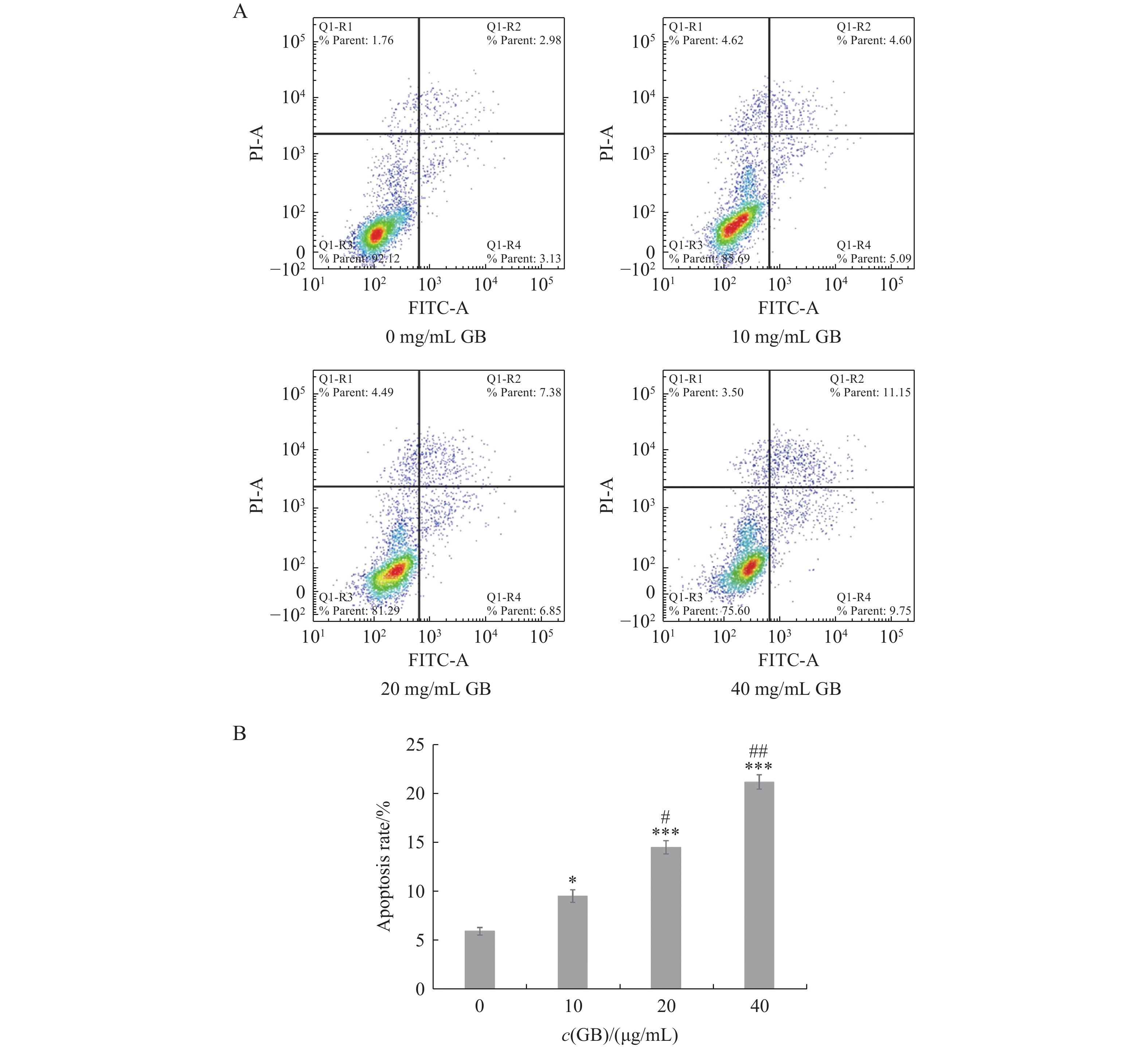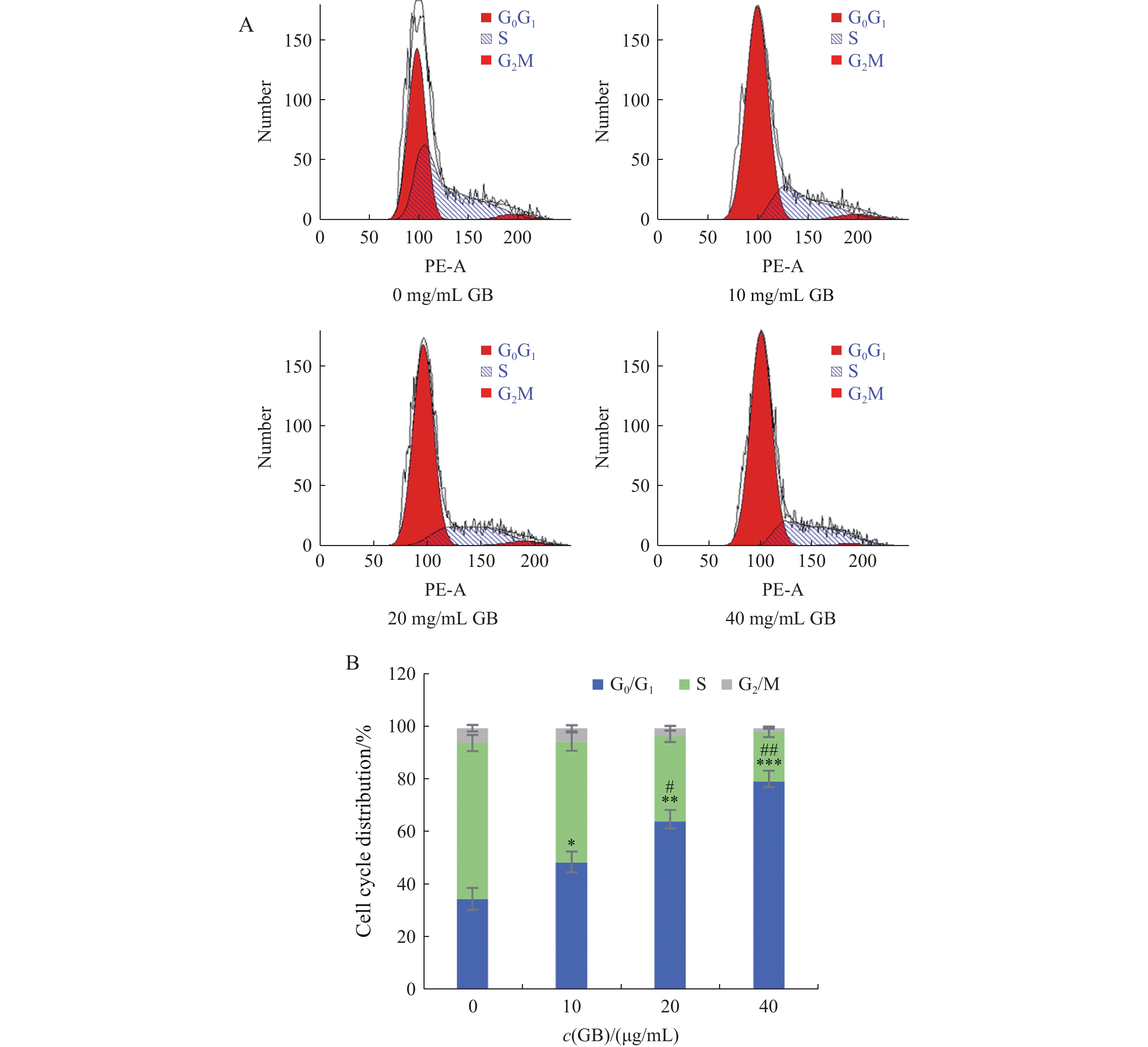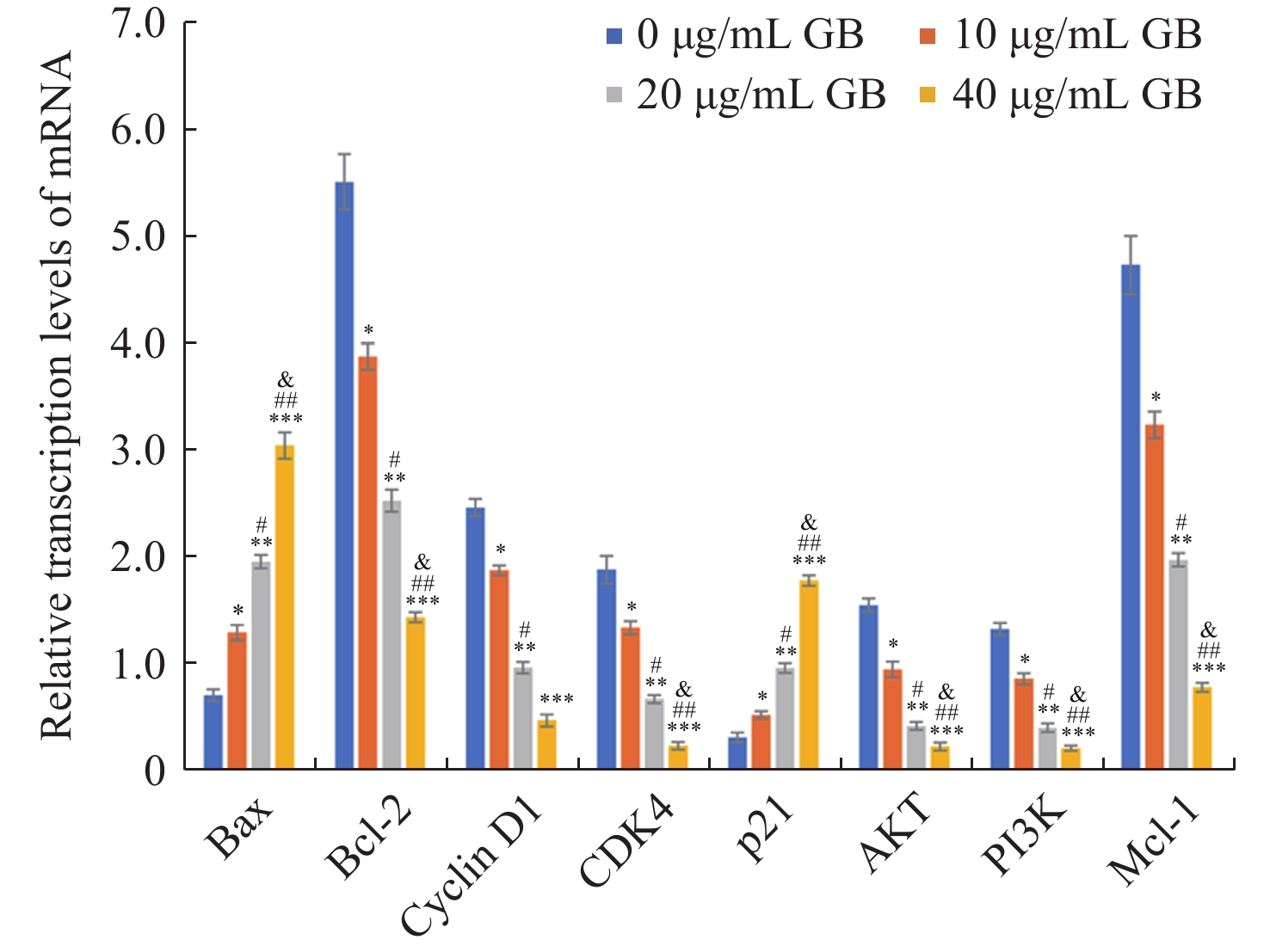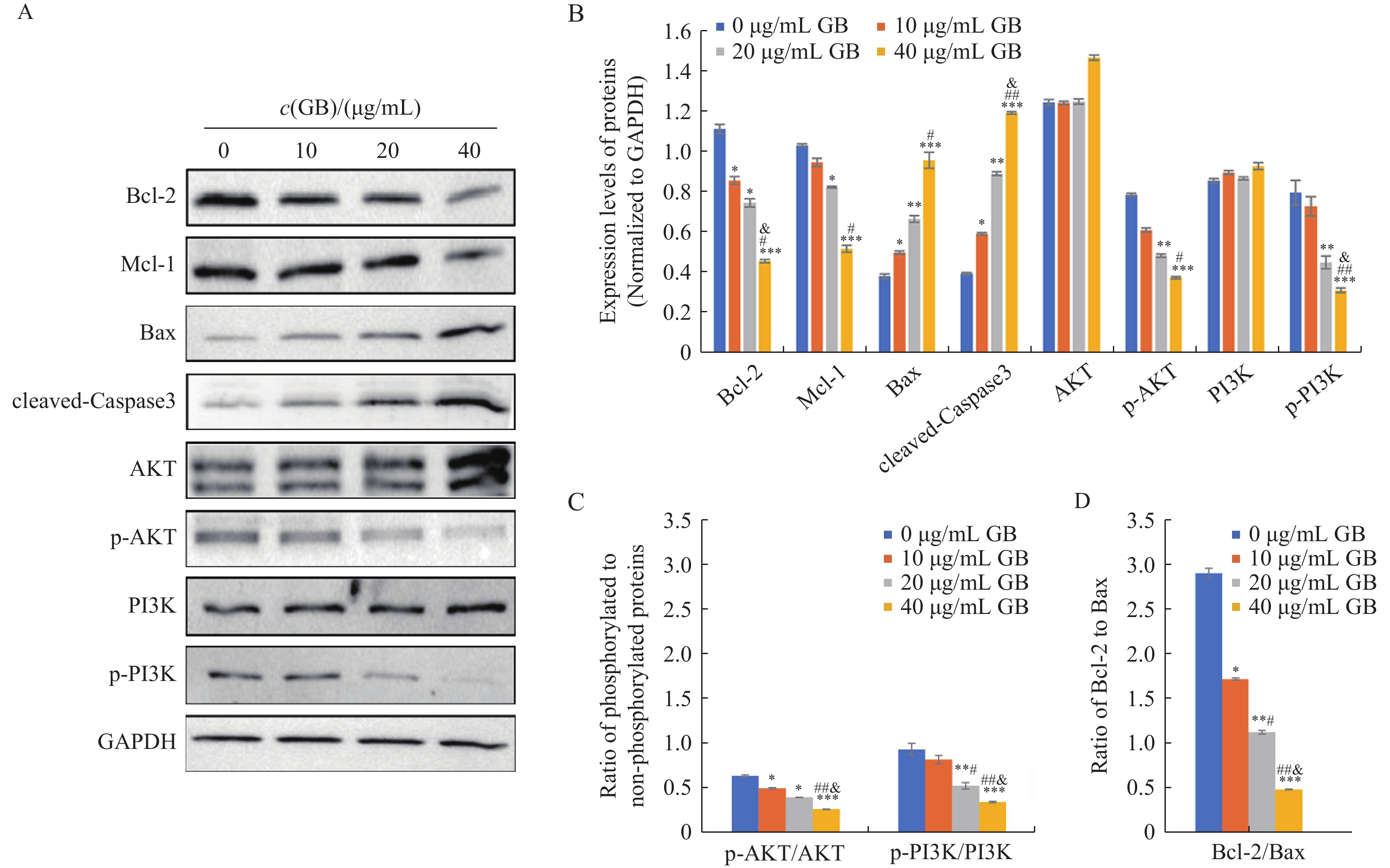Ginkgolide B inhibits cell proliferation and promotes cell apoptosis of MH7A human fibroblast-like synoviocytes through PI3K/AKT pathway
-
摘要:
探讨银杏内酯B(ginkgolide B,GB)对MH7A人成纤维样滑膜细胞(fibroblast-like synoviocytes,FLS)的增殖抑制作用及其潜在机制。采用20 μg/L肿瘤坏死因子-α(tumor necrosis factor-a,TNF-α)刺激MH7A构建关节炎细胞模型。经不同浓度GB作用于MH7A细胞后,CCK-8法检测细胞活力;Transwell实验检测细胞侵袭力;流式细胞术检测细胞凋亡率和细胞周期;实时荧光定量PCR(Real-time quantitative PCR,RT-qPCR)和蛋白免疫印迹分别检测基因转录和蛋白表达量。与对照组相比,GB对细胞活力的抑制作用呈现出一定的浓度和时间依赖性;GB显著抑制细胞侵袭力、增加细胞凋亡率和G0/G1期比例;GB显著上调细胞Bcl-2相关X蛋白(Bcl-2-associated X protein,Bax)和p21 mRNA和下降Bcl-2、髓系白血病1(myeloid cell leukemia 1,Mcl-1)、蛋白激酶B(protein kinase B,PKB;又称AKT)、磷脂酰肌醇-3激酶(phosphatidylinositol 3-kinase,PI3K)、Cyclin D1和细胞周期调节蛋白激酶4(cyclin-dependent kinase 4,CDK4)mRNA转录水平;同时,GB显著上调Bax、p21和Cleaved-caspase 3蛋白和下调Bcl-2、Mcl-1、p-AKT、p-PI3K、Cyclin D1和CDK4蛋白表达量,且伴有p-PI3K/PI3K、p-AKT/AKT和Bcl-2/Bax比值的降低。综上,GB通过抑制PI3K/AKT信号通路,阻滞MH7A细胞G1期向S期转化、抑制细胞活力和侵袭力,并诱导MH7A人成纤维样滑膜细胞凋亡。
-
关键词:
- 银杏内酯B /
- 磷脂酰肌醇3-激酶/蛋白激酶B /
- 类风湿性关节炎 /
- MH7A细胞 /
- 凋亡
Abstract:To explore the inhibitory effect of ginkgolide B (GB) on MH7A human fibroblast-like synoviocytes (FLS) and its potential mechanism. Firstly, 20 μg/L tumor necrosis factor-α (TNF-α) was pretreated with MH7A to establish a cell model of arthritis. After incubation of MH7A cells with various concentrations of GB, CCK-8 assay, Transwell assay, and flow cytometry (FCM) were separately used to detect cell viability, cell invasion, and cell apoptosis rate and cell cycle; Real-time quantitative PCR and Western blot assay were performed to detect the apoptosis- and cycle-related gene transcriptions and protein expressions, respectively. The results showed that compared with the control group, GB dose- and time-dependently suppressed cell viability to a greater extent; GB significantly reduced cell invasive ability and increased cell apoptosis rate and proportion of G0/G1 phase in MH7A cells, along with increased transcription levels of Bcl-2-associated X protein (Bax) and p21 mRNA and decreased transcription levels of Bcl-2, myeloid cell leukemia 1(Mcl-1), protein kinase B (PKB; AKT), IP3K, Cyclin D1 and cyclin-dependent kinase 4 (CDK4) mRNA; GB remarkably increased expression levels of Bax, p21, and cleaved-Caspase 3 protein and decreased expression levels of Bcl-2, Mcl-1, p-AKT, p-PI3K, Cyclin D1, and CDK4 protein, with decreased ratios of p-PI3K/PI3K, p-AKT/AKT, and Bcl-2/Bax. In conclusion, GB blocks the G1-to-S cell cycle transition, suppresses cell viability and cell invasion and induces cell apoptosis of MH7A human RA-FLS via suppressing the PI3K/AKT signaling pathway.
-
Keywords:
- ginkgolide B /
- PI3K/AKT /
- rheumatoid arthritis /
- MH7A cell /
- cell apoptosis
-
类风湿性关节炎(rheumatoid arthritis,RA)是一种由免疫系统异常激活和免疫耐受引起的自身免疫性疾病,其特征是过度滑膜增生和进行性关节破坏[1]。流行病学调查显示:RA几乎发生于全世界任何地区或各个民族,以女性多见,主要与遗传、雌激素、生殖和神经内分泌等宿主危险因素以及吸烟、空气暴露、外源性感染等环境风险因素有关[2];RA在全球的发病率为0.5%~1.0%,在中国大陆为0.42%[3]。成纤维样滑膜细胞(fibroblast-like synoviocytes,FLS)是人类RA滑膜组织中增生性滑膜的主要细胞类型,在高水平肿瘤坏死因子-α(tumor necrosis factor,TNF-α)等炎症因子的持续刺激下,表现出肿瘤样异常增殖、侵袭、凋亡障碍以及滑膜组织炎性增生和关节破坏等病理特点[4],由此可见FLS功能改变在RA进展过程中起到关键作用。因此,通过有效抑制RA-FLS异常过度增殖和侵袭以及促进其凋亡可能对减轻软骨破坏和改善RA临床症状有着重要作用。
MH7A是由RA患者的FLS经SV40T抗原基因转染而来的永生化细胞株,延续了人RA-FLS的特点,目前已成为RA病理机制和体外药物筛选的主要研究载体之一[5]。了解中草药有效成分在FLS凋亡中的诱导途径,不仅有助于阐明中药治疗RA的分子机制,而且有利于从天然草药中寻找新的候选治疗药物[6]。银杏内酯B(ginkgolide B,GB)是从银杏叶内提取的萜内酯类单体成分,具有抗炎、抗氧化活性和抗血栓形成的作用[7]。本实验通过研究GB对TNF-α诱导的MH7A细胞活力、侵袭力和凋亡的影响,初步探讨基于磷脂酰肌醇3-激酶(phosphatidylinositol 3-kinase,PI3K)/蛋白激酶B(protein kinase B,PKB/AKT)通路的相关蛋白,为临床抗RA的新药开发利用提供理论依据。
1. 材 料
1.1 试 剂
高糖DMEM培养基(美国Sigma-Aldrich公司);CCK-8试剂盒(日本同仁化学研究所);Matrigel胶(BD美国Biosciences公司);凋亡检测试剂盒(美国BD公司);TRIzol试剂盒[宝日医生物技术(北京)有限公司];SYBR®Green荧光定量检测试剂盒和GB(美国Sigma公司);放射免疫沉淀法(radioimmunoprecipitation assay,RIPA)细胞裂解液(武汉博士德生物工程有限公司);BCA试剂盒(广州伟伯科技有限公司);Bax、Bcl-2、Mcl-1、cleaved-Caspase 3、CyclinD1、CDK4、p21和p-AKT抗体(美国Abcam公司);PI3K和p-PI3K抗体(美国Cell Signaling Technology公司);AKT和GAPDH抗体(美国Proteintech公司);辣根过氧化物酶标记的羊抗兔IgG(美国Jackson Immuno Research公司);其他试剂均为市售分析纯。
细胞株来源于上海冠导生物科技有限公司。
1.2 仪 器
Multiskan FC酶标仪(美国ThermoFisher公司);IX53倒置显微镜(日本Olympus公司);FACS Calibur流式细胞分析仪(美国BD公司)。
2. 方 法
2.1 细胞培养
MH7A细胞培养参照文献[8−9]。MH7A细胞置于含10% FBS、青霉素(100 U/mL)-链霉素(100 μg/mL)的DMEM培养基中,置37 ℃、5% CO2培养箱培养。隔天加入含20 μg/L TNF-α的DMEM培养基中继续培养,选取TNF-α刺激下MH7A对数生长期的细胞进行传代和后续试验。
2.2 CCK-8法检测细胞活力
离心收集经0.25%胰酶消化处理的MH7A细胞(每升5×107个),将每孔单细胞悬液100 μL接种于96孔板,置37 ℃、5% CO2细胞培养箱培养。待细胞贴壁生长24 h后,将原培养液更换为20 μg/L TNF-α的DMEM培养基和不同质量浓度的GB(0、10、20、40和80 μg/mL),分别继续培养24、48和72 h。弃去含药培养液,每孔加入CCK-8应用液10 μL,37 ℃避光反应,1 h后应用Multiskan FC酶标仪测量450 nm处各孔的吸收度A,用各实验组A与对照组A的比值表示细胞活力。
2.3 Transwell实验检测细胞侵袭力
将MH7A细胞(约每孔1.0×104个)接种到涂有Matrigel胶(1∶5稀释)的Transwell小室(直径6.5 mm,孔径8.0 μm)的上室,置于终浓度为20 μg/L TNF-α的DMEM培养基中,分别加入质量浓度为0、10、20和40 μg/mL GB;下室中加入含有20%胎牛血清的DMEM培养基。在37 ℃、5% CO2条件下培养,24 h后用磷酸盐缓冲液(phosphate buffered saline,PBS)洗涤小室3次,并用棉签擦拭小室内表面的细胞,用4%多聚甲醛固定迁移至小室外膜下的细胞20 min,然后用0.1%结晶紫染色10 min。再次用PBS洗涤细胞后,采用Image J软件(2.6版)随机拍摄倒置显微镜下5个视野中各组细胞图像并进行计数。
2.4 流式细胞术(flow cytometry, FCM)检测细胞凋亡率
离心收集经0.25%胰酶消化处理的MH7A细胞(每升5×107个),将每孔单细胞悬液2 mL接种于6孔板,置37 ℃、5% CO2细胞培养箱,待细胞贴壁生长24 h后,更换原培养液为含20 μg/L TNF-α以及含质量浓度0、10、20和40 μg/mL GB的DMEM培养基,继续培养48 h。胰酶消化后收集细胞,预冷PBS洗涤细胞2次,加结合缓冲液(1×)500 μL悬浮细胞,并依次加入膜联蛋白V(annexin V)-异硫氰酸荧光素(fluorescein isothiocyanate,FITC)5 μL和碘化丙啶(propidium iodide,PI)5 μL,轻轻混匀,置4 ℃暗处孵育15 min,采用FCM检测细胞凋亡率,并用BD Accuri C6 软件分析实验数据。
2.5 FCM检测细胞周期
同“2.4”项下方法预处理MH7A细胞48 h,胰酶消化细胞,PBS洗涤细胞2次;经预冷的70%乙醇固定并低温下孵育3 h,离心洗涤后,悬浮于50 μg/mL PI染液中,室温下避光振摇,调整细胞浓度为每毫升1×106个,30 min内上FCM检测细胞周期分布。
2.6 实时荧光定量聚合酶链式反应(RT-qPCR)检测mRNA转录
同“2.4”预处理MH7A细胞48 h,消化收集细胞,采用TRIzol试剂盒提取总核糖核酸(ribonucleic acid,RNA)和测定其浓度、反转录试剂盒逆转录成互补脱氧核糖核酸(complementary DNA,cDNA),以GAPDH为内参,按照SYBR®Green荧光定量检测试剂盒的操作流程进行PCR定量测定目的基因mRNA表达。引物序列由上海生物工程有限公司合成,Bcl-2正义链为5′-GGTGGGGTCATGTGTGTGG-3′,反义链为5′-CGGTTCAGGTACTCAGTCATCC-3′;Bax正义链为5′-CCCGAGAGGTCTTTTTCCGAG-3′,反义链为5′-CCAGCCCATGATGGTTCTGAT-3′;CyclinD1正义链为5′-GCTGCGAAGTGGAAACCATC-3′,反义链为5′-CCTCCTTCTGCACACATTTGAA-3′;AKT正义链为5'-TCCTCCTCAAGAATGATGGCA-3',反义链为5'-GTGCGTTCGATGACAGTGGT-3';PI3K正义链为5'-AAACAGAGCCAAAGGGAAGG-3',反义链为5'-ATACC AGCCACAAAGGCTTC-3';Mcl-1正义链为5'-AGACGATGTGAAATCG-3',反义链为5'-TAACTAGCCAGTCCCG-3';CDK4正义链为5'-GAGGCGACTGGAGGCTTTT-3',反义链为5'-GGATGTGCACAGACGTCC-3';p21正义链为5'-GCCCA GTGGACAGCGAGCAG-3',反义链为5'-GCCGGCGTTTGGAGTGGTAG-3';GAPDH正义链为5′-GCACCGTCAAGGCTGAGAAC-3′,反义链为5′-TGGTGA AGACGCCAGTGGA-3′。PCR扩增程序如下:95 ℃变性30 s,95 ℃变性5 s,60 ℃退火30 s,65 ℃延长1 min,35个循环,每个样品设3个复孔。最后用2-ΔΔCt方法计算目的基因mRNA相对表达量。
2.7 Western blot检测蛋白表达
同“2.4”项下方法预处理MH7A细胞48 h,消化收集细胞,加入RIPA细胞裂解液后置于冰上裂解30 min,以提取各组总蛋白。经
1000 r/min离心5 min,采用BCA试剂盒测定上清液蛋白含量。蛋白变性后十二烷基硫酸钠聚丙烯酰胺凝胶电泳,转膜,5%脱脂牛奶封闭,1 h后用含Tween-20的Tris 盐缓冲液(tris-borate-sodium Tween-20,TBST)漂洗3次(×15 min),分别加入1∶1000 稀释的Bax、Bcl-2、Mcl-1、cleaved-Caspase 3、CyclinD1、CDK4、p21、AKT、p-AKT、PI3K、p-PI3K和GAPDH一抗,置4 °C摇床孵育过夜。TBST漂洗后加入1∶5000 稀释的辣根过氧化物酶标记的羊抗兔IgG二抗,常温孵育1 h。TBST再次漂洗后加入电化学发光工作液显色,应用Image J 1.44软件分析各蛋白条带灰度值。2.8 统计学分析
计量资料以$ \bar{x } \pm s $表示,组间比较采用t检验或方差分析;计数资料以率(%)表示,组间比较采用χ2检验;用SPSS 26.0统计学软件进行数据分析,以P < 0.05为差异有统计学意义。
3. 结 果
3.1 对MH7A细胞活力和细胞侵袭力的影响
与对照组相比,同一干预时间点,各组MH7A细胞活力伴随着GB浓度的增大呈现出下降趋势;同一质量浓度GB(< 80 μg/mL)作用MH7A细胞不同时间,细胞活力伴随着作用时间延长呈现出下降趋势,差异均有统计学意义(P < 0.05)。当GB达80 μg/mL时,48 和72 h的细胞存活率均小于50%,但两组间差异无统计学意义(P > 0.05)(图1)。鉴于上述CCK-8检测结果,选择10,20和40 μg/mL GB为后续实验研究。
![]() Figure 1. Effects of ginkgolide B (GB) on MH7A cell viability and cell invasion ($ \bar{x } \pm s $,n=6)A: Cell viability determined by CCK-8 assay after incubation of MH7A cells with 0 (control group),10,20,40, and 80 μg/mL GB for 24,48 and 72 h; B: Representative image of cell invasion detected by Transwell assay after incubation of MH7A cells with 0 (control group),10,20 and 40 μg/mL GB for 24 h; C: Bar graph of cell invasion ability in MH7A cells *P < 0.05, **P < 0.01, ***P < 0.001 vs control group; #P<0.05, ##P < 0.01 vs 10 μg/mL GB group
Figure 1. Effects of ginkgolide B (GB) on MH7A cell viability and cell invasion ($ \bar{x } \pm s $,n=6)A: Cell viability determined by CCK-8 assay after incubation of MH7A cells with 0 (control group),10,20,40, and 80 μg/mL GB for 24,48 and 72 h; B: Representative image of cell invasion detected by Transwell assay after incubation of MH7A cells with 0 (control group),10,20 and 40 μg/mL GB for 24 h; C: Bar graph of cell invasion ability in MH7A cells *P < 0.05, **P < 0.01, ***P < 0.001 vs control group; #P<0.05, ##P < 0.01 vs 10 μg/mL GB group经不同质量浓度GB作用MH7A细胞24 h,Transwell试验结果显示:与对照组相比,TNF-α刺激下的MH7A细胞侵袭能力伴随着GB浓度的升高而显著降低(P < 0.05)。且20和40 μg/mL GB组细胞侵袭力均较10 μg/mL GB组明显下降(P < 0.05)。
3.2 对MH7A细胞凋亡率的影响
经不同浓度GB作用MH7A细胞48 h,各组细胞凋亡率均较对照组细胞增高,并且细胞凋亡率伴随着GB浓度的增大呈现出增高趋势(P < 0.05)(图2)。
![]() Figure 2. GB on cell apoptosis ($\bar{x } \pm s $, n=3)A: Representative flow cytometry analysis of cell apoptosis after incubation of MH7A cells with 0 (control group),10,20, and 40 μg/mL GB for 48 h; B: Bar graph of cell apoptosis in MH7A cells *P < 0.05, ***P < 0.001 vs control group; #P < 0.05, ##P < 0.01 vs 10 μg/mL GB group
Figure 2. GB on cell apoptosis ($\bar{x } \pm s $, n=3)A: Representative flow cytometry analysis of cell apoptosis after incubation of MH7A cells with 0 (control group),10,20, and 40 μg/mL GB for 48 h; B: Bar graph of cell apoptosis in MH7A cells *P < 0.05, ***P < 0.001 vs control group; #P < 0.05, ##P < 0.01 vs 10 μg/mL GB group3.3 对MH7A细胞周期的影响
与对照组相比,不同浓度GB作用MH7A细胞48 h后,各组G0/G1期细胞比例呈上升趋势(P < 0.05),S期细胞比例呈下降趋势(P < 0.05),但G2/M期细胞比例呈下降趋势,但各组间差异无统计学意义(P > 0.05)(图3),提示GB浓度依赖性地阻滞MH7A细胞于G0/G1期。
![]() Figure 3. Effect of GB on cell cycle ($ \bar{x } \pm s $, n=3)A: Representative FCM analysis of cell cycle after incubation of MH7A cells with 0 (control group),10,20 and 40 μg/mL GB for 48 h; B: Bar graph of cell cycle distribution in MH7A cells *P < 0.05, **P < 0.01, ***P < 0.001 vs control group; #P < 0.05, ##P < 0.01 vs 10 μg/mL GB group
Figure 3. Effect of GB on cell cycle ($ \bar{x } \pm s $, n=3)A: Representative FCM analysis of cell cycle after incubation of MH7A cells with 0 (control group),10,20 and 40 μg/mL GB for 48 h; B: Bar graph of cell cycle distribution in MH7A cells *P < 0.05, **P < 0.01, ***P < 0.001 vs control group; #P < 0.05, ##P < 0.01 vs 10 μg/mL GB group3.4 对MH7A细胞mRNA转录水平的影响
与对照组相比,不同浓度GB作用MH7A细胞48 h,各组Bax 和p21 mRNA转录水平均显示出升高趋势,而Bcl-2、Cyclin D1、CDK4、AKT、PI3K 和Mcl-1 mRNA转录水平均呈现出下降趋势,且随着GB质量浓度的增大,作用效果越明显(P < 0.05)(图4)。
![]() Figure 4. Effect of GB on the transcription levels of mRNA ($ \bar{x } \pm s $, n=3)qRT-PCR analysis of levels of transcription mRNA after incubation of MH7A cells with 0 (control group),10,20, and 40 μg/mL GB for 48 h *P < 0.05, **P < 0.01, *** P < 0.001 vs control group; # P < 0.05, ##P < 0.01 vs 10 μg/mL GB group; &P < 0.05 vs 20 μg/mL GB group
Figure 4. Effect of GB on the transcription levels of mRNA ($ \bar{x } \pm s $, n=3)qRT-PCR analysis of levels of transcription mRNA after incubation of MH7A cells with 0 (control group),10,20, and 40 μg/mL GB for 48 h *P < 0.05, **P < 0.01, *** P < 0.001 vs control group; # P < 0.05, ##P < 0.01 vs 10 μg/mL GB group; &P < 0.05 vs 20 μg/mL GB group3.5 对MH7A细胞凋亡相关蛋白表达水平的影响
与对照组相比,不同浓度GB作用MH7A细胞48 h,各组Bax和cleaved-Caspase 3蛋白表达量均呈现出上升趋势,而Bcl-2、Mcl-1、p-AKT和p-PI3K蛋白表达量均呈现出下降趋势(图5-A,5-B),并伴有p-PI3K/PI3K、p-AKT/AKT(图5-C)和Bcl-2/Bax比值降低(图5-D),且随着GB质量浓度的增加,作用效果越明显(P < 0.05)。
![]() Figure 5. Effect of GB on the expression levels of apoptosis-related protein ($ \bar{x } \pm s $, n=3)A: Representative image of Western blot assay after incubation of MH7A cells with 0 (control group),10,20, and 40 μg/mL GB for 48 h; B: Relative expression levels of apoptosis-related proteins; C: Ratio of phosphorylated to non-phosphorylated proteins; D: Ratio of Bcl-2 to Bax protein *P < 0.05, **P < 0.01, *** P < 0.001 vs control group; # P<0.05, ##P<0.01 vs 10 μg/mL GB group; &P<0.05 vs 20 μg/mL GB group
Figure 5. Effect of GB on the expression levels of apoptosis-related protein ($ \bar{x } \pm s $, n=3)A: Representative image of Western blot assay after incubation of MH7A cells with 0 (control group),10,20, and 40 μg/mL GB for 48 h; B: Relative expression levels of apoptosis-related proteins; C: Ratio of phosphorylated to non-phosphorylated proteins; D: Ratio of Bcl-2 to Bax protein *P < 0.05, **P < 0.01, *** P < 0.001 vs control group; # P<0.05, ##P<0.01 vs 10 μg/mL GB group; &P<0.05 vs 20 μg/mL GB group3.6 对MH7A细胞中周期相关蛋白表达水平的影响
与对照组相比,不同浓度GB作用MH7A细胞48 h,各组p21蛋白表达量呈现出上升趋势,而CyclinD1和CDK4蛋白表达量均呈现出下降趋势,且伴随着GB质量浓度的增加,作用效果越明显(P < 0.05)(图6-A,6-B)。
![]() Figure 6. Effect of GB on the expression levels of cell cycle-related protein ($ \bar{x } \pm s $, n=3)MH7A cells were collected and the expression levels of protein were quantitatively determined by Western blot assay after incubation with 0 (control group),10,20, and 40 μg/mL GB for 48 h *P < 0.05, **P < 0.01, ***P < 0.001 vs control group; #P < 0.05, ##P < 0.01 vs 10 μg/mL GB group; &P<0.05 vs 20 μg/mL GB group
Figure 6. Effect of GB on the expression levels of cell cycle-related protein ($ \bar{x } \pm s $, n=3)MH7A cells were collected and the expression levels of protein were quantitatively determined by Western blot assay after incubation with 0 (control group),10,20, and 40 μg/mL GB for 48 h *P < 0.05, **P < 0.01, ***P < 0.001 vs control group; #P < 0.05, ##P < 0.01 vs 10 μg/mL GB group; &P<0.05 vs 20 μg/mL GB group4. 讨 论
目前,临床上针对RA的治疗目标主要是控制疾病症状、减缓疾病进一步损害[10]。中药银杏叶的二萜类化合物GB具有明显的抗炎和抗肿瘤等药理作用[11−12]。GB通过下调TLR4-NF-κB通路抑制小胶质BV2细胞活化及炎症反应[13]。最近研究表明,GB还能够通过抑制JAK2/STAT3信号通路发挥其抗肿瘤作用[12]。本研究中GB干预高浓度TNF-α持续刺激下的MH7A细胞,其肿瘤样异常增殖和侵袭能力均呈现出明显下降。Xie等[14]证实了GB具有减轻类风湿关节炎模型中小鼠关节软骨和骨质的破坏等作用,其机制与Wnt5a/JNK/NF-κB轴调控的RA-FLSs凋亡和炎性细胞因子释放有关。上述数据表明GB有助于抑制RA滑膜组织中FLS异常增殖和侵袭,缓解RA的症状和疾病进展。
RA发病机制复杂,涉及细胞内多种信号分子的调节,其中P13K/AKT信号通路为重要的信号转导通路之一[6,15]。活化的AKT激活或抑制PI3K/AKT信号通路的下游靶点,在细胞增殖、侵袭转移、周期和凋亡相关靶点的调控中发挥着重要作用[16]。在各种促进细胞炎性增殖的反应中,首先可通过调节G1期检查点分子和活化AKT信号传导来促进G1期到S期转变,从而加速人非小细胞肺癌的生长[17]。值得注意的是,1×10−9~1×10−5 mol/L GB浓度依赖性抑制牛主动脉平滑肌细胞增殖,其与细胞周期G1期转换到S期阻滞有关[18]。本研究中GB通过下调Cyclin D1和CDK4以及上调p21基因转录和蛋白表达,阻滞MH7A细胞G1期向S期转化,从而影响DNA复制和抑制其增殖。
细胞凋亡是细胞的一种基本生物学现象,在多细胞生物去除不需要的或异常细胞中起着关键性作用[19]。研究发现,PI3K/AKT通路中AKT活化可激活其下游靶点Bax,增强Bcl-2因子的转录,发挥抗凋亡作用[20−21]。Caspase家族中的caspase 3是细胞凋亡最重要的调控蛋白,参与细胞凋亡启动和执行过程[22]。GB通过活性氧生成、c-Jun N末端激酶激活、线粒体膜电位丧失和caspase-3激活诱导小鼠胚胎干细胞(ESC-B5)凋亡[23]。本研究中GB剂量依赖性地上调Bax基因转录和蛋白表达量、下调MH7A细胞中Bcl-2、Mcl-1、AKT和PI3K基因转录以及p-PI3K、p-AKT、Bcl-2和Mcl-1蛋白表达量,致使p-PI3K/PI3K、p-AKT/AKT和Bcl-2/Bax比值下降。其中Bcl-2/Bax比值下降可导致线粒体外孔膜形成,释放细胞色素C入胞质,激活下游的cleaved-Caspase 3表达量增加,并进一步促进MH7A细胞凋亡。
综上所述,GB通过抑制PI3K/AKT信号通路,阻滞MH7A细胞G1期向S期转化、抑制细胞活力和侵袭力,并诱导人成纤维样滑膜MH7A细胞凋亡。这可能是GB抗RA的信号分子调节机制之一,但该作用机制还有待于进一步体内研究。
欢迎订阅 2025年《中国药科大学学报》 国内刊号:CN 32-1157/R ISSN:1000-5048 国内邮发代号:28-115 定 价:40元/期,全年240元 地 址:南京市童家巷24号 邮政编码:210009 电 话:025-83271566 https://jcpu.cpu.edu.cn -
Figure 1. Effects of ginkgolide B (GB) on MH7A cell viability and cell invasion ($ \bar{x } \pm s $,n=6)
A: Cell viability determined by CCK-8 assay after incubation of MH7A cells with 0 (control group),10,20,40, and 80 μg/mL GB for 24,48 and 72 h; B: Representative image of cell invasion detected by Transwell assay after incubation of MH7A cells with 0 (control group),10,20 and 40 μg/mL GB for 24 h; C: Bar graph of cell invasion ability in MH7A cells *P < 0.05, **P < 0.01, ***P < 0.001 vs control group; #P<0.05, ##P < 0.01 vs 10 μg/mL GB group
Figure 2. GB on cell apoptosis ($\bar{x } \pm s $, n=3)
A: Representative flow cytometry analysis of cell apoptosis after incubation of MH7A cells with 0 (control group),10,20, and 40 μg/mL GB for 48 h; B: Bar graph of cell apoptosis in MH7A cells *P < 0.05, ***P < 0.001 vs control group; #P < 0.05, ##P < 0.01 vs 10 μg/mL GB group
Figure 3. Effect of GB on cell cycle ($ \bar{x } \pm s $, n=3)
A: Representative FCM analysis of cell cycle after incubation of MH7A cells with 0 (control group),10,20 and 40 μg/mL GB for 48 h; B: Bar graph of cell cycle distribution in MH7A cells *P < 0.05, **P < 0.01, ***P < 0.001 vs control group; #P < 0.05, ##P < 0.01 vs 10 μg/mL GB group
Figure 4. Effect of GB on the transcription levels of mRNA ($ \bar{x } \pm s $, n=3)
qRT-PCR analysis of levels of transcription mRNA after incubation of MH7A cells with 0 (control group),10,20, and 40 μg/mL GB for 48 h *P < 0.05, **P < 0.01, *** P < 0.001 vs control group; # P < 0.05, ##P < 0.01 vs 10 μg/mL GB group; &P < 0.05 vs 20 μg/mL GB group
Figure 5. Effect of GB on the expression levels of apoptosis-related protein ($ \bar{x } \pm s $, n=3)
A: Representative image of Western blot assay after incubation of MH7A cells with 0 (control group),10,20, and 40 μg/mL GB for 48 h; B: Relative expression levels of apoptosis-related proteins; C: Ratio of phosphorylated to non-phosphorylated proteins; D: Ratio of Bcl-2 to Bax protein *P < 0.05, **P < 0.01, *** P < 0.001 vs control group; # P<0.05, ##P<0.01 vs 10 μg/mL GB group; &P<0.05 vs 20 μg/mL GB group
Figure 6. Effect of GB on the expression levels of cell cycle-related protein ($ \bar{x } \pm s $, n=3)
MH7A cells were collected and the expression levels of protein were quantitatively determined by Western blot assay after incubation with 0 (control group),10,20, and 40 μg/mL GB for 48 h *P < 0.05, **P < 0.01, ***P < 0.001 vs control group; #P < 0.05, ##P < 0.01 vs 10 μg/mL GB group; &P<0.05 vs 20 μg/mL GB group
-
[1] Li N, Jiang L, Cai YH, et al. The correlation between interleukin-34 and bone erosion under ultrasound in rheumatoid arthritis[J]. Mod Rheumatol, 2020, 30(2): 269-275. doi: 10.1080/14397595.2019.1593576
[2] Romão VC, Fonseca JE. Etiology and risk factors for rheumatoid arthritis: a state-of-the-art review[J]. Front Med (Lausanne), 2021, 8: 689698.
[3] Tian XP, Wang Q, Li MT, et al. 2018 Chinese guidelines for the diagnosis and treatment of rheumatoid arthritis[J]. Rheumatol Immunol Res, 2021, 2(1): 1-14. doi: 10.2478/rir-2021-0002
[4] Chen YX, Dang JL, Lin XR, et al. RA fibroblast-like synoviocytes derived extracellular vesicles promote angiogenesis by mirna-1972 targeting p53/MTOR signaling in vascular endotheliocyte[J]. Front Immunol, 2022, 13: 793855. doi: 10.3389/fimmu.2022.793855
[5] Castrejon I. Evaluation and monitoring of established rheumatoid arthritis[J]. Best Pract Res Clin Rheumatol, 2019, 33(5): 101480. doi: 10.1016/j.berh.2019.101480
[6] Zhang Q, Liu J, Zhang MM, et al. Apoptosis induction of fibroblast-like synoviocytes is an important molecular-mechanism for herbal medicine along with its active components in treating rheumatoid arthritis[J]. Biomolecules, 2019, 9(12): 795. doi: 10.3390/biom9120795
[7] Meng W, Ye HB, Ma ZF, et al. Perfluorocarbon nanoparticles incorporating ginkgolide b: artificial O2 carriers with antioxidant activity and antithrombotic effect[J]. Chem Med Chem, 2024, 19(1): e202300312. doi: 10.1002/cmdc.202300312
[8] Yang JL, Li YX, Wang LL, et al. LncRNA H19 aggravates TNF-α-induced inflammatory injury via TAK1 pathway in MH7A cells[J]. Biofactors, 2020, 46(5): 813-820. doi: 10.1002/biof.1659
[9] Mo X, Chen J, Wang X, et al. Krüppel-like factor 4 regulates the expression of inducible nitric oxide synthase induced by TNF-α in human fibroblast-like synoviocyte MH7A cells[J]. Mol Cell Biochem, 2018, 438: 77-84. doi: 10.1007/s11010-017-3115-9
[10] Wang Y, Chen S, Du K, et al. Traditional herbal medicine: therapeutic potential in rheumatoid arthritis[J]. J Ethnopharmacol, 2021, 279: 114368. doi: 10.1016/j.jep.2021.114368
[11] Xiang YJ, Zhang SY, Lu J, et al. Ginkgolide B protects human pulmonary alveolar epithelial A549 cells from lipopolysaccharide-induced inflammatory responses by reducing TRIM37-mediated NF-κB activation[J]. Biotechnol Appl Biochem, 2020, 67(6): 903-911. doi: 10.1002/bab.1847
[12] Chen K, Sun WJ, Jiang Y, et al. Ginkgolide B suppresses TLR4-mediated inflammatory response by inhibiting the phosphorylation of JAK2/STAT3 and p38 MAPK in high glucose-treated HUVECs[J]. Oxid Med Cell Longev, 2017, 2017: 9371602. doi: 10.1155/2017/9371602
[13] Wan F, Zang SS, Yu GQ, et al. Ginkgolide B suppresses methamphetamine-induced microglial activation through TLR4-NF-κB signaling pathway in BV2 cells[J]. Neurochem Res, 42 (10): 2881-2891.
[14] Xie CM, Jiang J, Liu JP, et al. Ginkgolide B attenuates collagen-induced rheumatoid arthritis and regulates fibroblast-like synoviocytes-mediated apoptosis and inflammation[J]. Ann Transl Med, 2020, 8(22): 1497. doi: 10.21037/atm-20-6420
[15] Rahmani F, Ziaeemehr A, Shahidsales S, et al. Role of regulatory miRNAs of the PI3K/AKT/mTOR signaling in the pathogenesis of hepatocellular carcinoma[J]. J Cell Physiol, 2020, 235(5): 4146-4152. doi: 10.1002/jcp.29333
[16] Chen KL, Zhu PF, Chen WH, et al. Melatonin inhibits proliferation, migration, and invasion by inducing ROS-mediated apoptosis via suppression of the PI3K/Akt/mTOR signaling pathway in gallbladder cancer cells[J]. Aging (Albany NY), 2021, 13(18): 22502-22515.
[17] Zhao YY, Ye X, Chen RF, et al. Sirtuin 7 promotes non-small cell lung cancer progression by facilitating G1/S phase and epithelial-mesenchymal transition and activating AKT and ERK1/2 signaling[J]. Oncol Rep, 202, 44 (3): 959-972.
[18] Wei EH, Rao MR, Ji ND, et al. Inhibitory effects of ginkgolide B on proliferation of bovine aortic smooth muscle cells[J]. Acta Pharm Sin, 2002, 37(2): 90-93.
[19] Sun R, Zhai R, Ma C, et al. Combination of aloin and metformin enhances the antitumor effect by inhibiting the growth and invasion and inducing apoptosis and autophagy in hepatocellular carcinoma through PI3K/Akt/mTOR pathway[J]. Cancer Med, 2020, 9(3): 1141-1151. doi: 10.1002/cam4.2723
[20] Wang LF, Wang N, Zhao Q, et al. Pectolinarin inhibits proliferation, induces apoptosis, and suppresses inflammation in rheumatoid arthritis fibroblast-like synoviocytes by inactivating the phosphatidylinositol 3 kinase/protein kinase B pathway[J]. J Cell Biochem, 2019, 120(9): 15202-15210. doi: 10.1002/jcb.28784
[21] Zhou MJ, Tan W, Hasimu H, et al. Euphorbium total triterpenes improve Freund's complete adjuvant-induced arthritis through PI3K/AKT/Bax and NF-κB/NLRP3 signaling pathways[J]. J Ethnopharmacol, 2023, 306: 116146. doi: 10.1016/j.jep.2023.116146
[22] Nichani K, Li JZ, Suzuki M, et al. Evaluation of Caspase-3 activity during apoptosis with fluorescence lifetime-based cytometry measurements and phasor analyses[J]. Cytometry A, 2020, 97(12): 1265-1275. doi: 10.1002/cyto.a.24207
[23] Chan WH. Ginkgolide B induces apoptosis and developmental injury in mouse embryonic stem cells and blastocysts[J]. Hum Reprod, 2006, 21(11): 2985-2895. doi: 10.1093/humrep/del255




 下载:
下载:






